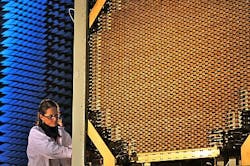ARLINGTON, Va., 14 Nov. 2012. Advanced antenna designers at Teledyne Scientific and Imaging LLC in Thousand Oaks, Calif. will continue their work to develop smart reconfigurable RF transceivers for future military radar and communications systems under terms of an upcoming contract from the U.S. Defense Advanced Research Projects Agency (DARPA) in Arlington, Va.
Officials of the DARPA Microsystems Technology Office (MTO) announced plans late last week to award an 18 month sole-source contract to Teledyne for phase IIIB of the Scalable Millimeter-wave Architectures for Reconfigurable Transceivers (SMART) program.
The DARPA SMART initiative seeks to develop 3-dimensional monolithic microwave integrated circuit (MMIC) technology to fit small power amplifiers between transmit-receive nodes in a phased array antenna to enhance the efficiency and sensitivity of radar and communications systems.
The SMART program essentially seeks to develop wafer-scale integration for RF and microwave transmit/receive modules. The contract amount has not yet been negotiated. Teledyne scientists performed previous SMART work in phases I, II, and IIIA.
Teledyne engineers so far have developed 44-GHz transmit sub-arrays, added transmit and receive functionality, and developed a functional Q-band transmit array, DARPA officials say. The company demonstrated a millimeter wave tiled array by inventing an integration process for silicon digital beam-forming electronics and compound indium phosphide power amplifier MMICs.
Teledyne experts combined these elements into planar antenna technology by developing a three-dimensional silicon interposer to fabricate small-form-factor, wide-scan apertures, DARPA officials explain.
The Teledyne known-good-die packaging approach forms the foundation of the company's ability to develop a silicon interposer and fabrication process flows for blending different integrated circuits on one die, including digital integrated circuits, MMICs and other active and passive components. The interposer performs as a compact package that connects RF transceiver components.
The current contract calls for Teledyne to create high-yield SMART components at advanced technology readiness levels, batch processing capability, and to supply key components. Phase III focuses on moving SMART technology to batch fabrication for a military application that requires millimeter-wave functionality.
More information about the upcoming DARPA SMART contract to Teledyne is online at https://www.fbo.gov/spg/ODA/DARPA/CMO/DARPA-SN-13-05/listing.html.
For more information contact Teledyne Scientific and Imaging online at www.teledyne-si.com, or the DARPA Microsystems Technology Office at www.darpa.mil/our_work/mto.



